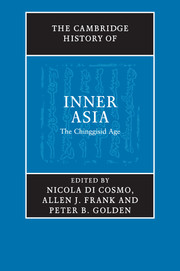Book contents
- Frontmatter
- Contents
- List of figure and maps
- List of contributors
- Note on transliteration
- List of abbreviations
- Maps
- Introduction
- PART ONE THE RISE OF THE CHINGGISIDS
- Part Two LEGACIES OF THE MONGOL CONQUESTS
- 5 Institutional development, revenues and trade
- 6 Migrations, ethnogenesis
- 7 Islamization in the Mongol Empire
- 8 Mongols as vectors for cultural transmission
- Part Three CHINGGISID DECLINE: 1368–c. 1700
- Part Four NOMADS AND SETTLED PEOPLES IN INNER ASIA AFTER THE TIMURIDS
- Part Five NEW IMPERIAL MANDATES AND THE END OF THE CHINGGISID ERA (18th–19th CENTURIES)
- Bibliography
- Index
7 - Islamization in the Mongol Empire
from Part Two - LEGACIES OF THE MONGOL CONQUESTS
Published online by Cambridge University Press: 05 March 2014
- Frontmatter
- Contents
- List of figure and maps
- List of contributors
- Note on transliteration
- List of abbreviations
- Maps
- Introduction
- PART ONE THE RISE OF THE CHINGGISIDS
- Part Two LEGACIES OF THE MONGOL CONQUESTS
- 5 Institutional development, revenues and trade
- 6 Migrations, ethnogenesis
- 7 Islamization in the Mongol Empire
- 8 Mongols as vectors for cultural transmission
- Part Three CHINGGISID DECLINE: 1368–c. 1700
- Part Four NOMADS AND SETTLED PEOPLES IN INNER ASIA AFTER THE TIMURIDS
- Part Five NEW IMPERIAL MANDATES AND THE END OF THE CHINGGISID ERA (18th–19th CENTURIES)
- Bibliography
- Index
Summary
Understanding the historical process of Islamization in the Mongol-ruled world, and amongst the Mongols themselves, is complicated by the nature of the sources, often themselves religious in their inspiration, through which we see the effects of that process, and even more so by the assumptions we bring to the issue of religious conversion and how it ought to be measured or detected. In both regards, it is important to ask questions of our sources that are more fruitful than those typically posed in the past, with regard to:
(1) the bearers or ‘vectors’ of Islamization, comprising not only representatives of Islam who went among the Mongols to do the work of conversion, but also the ‘internal’ representatives of Islam and of its institutional and communal infrastructure within the areas, and among the peoples, conquered by the Mongols;
(2) the targets of Islamization, both the elites, especially the rulers, and the ordinary nomads who formed the basis of the Mongols' military power;
(3) the factors facilitating religious change and its social accompaniments, including, for example, social and cultural prestige, enhanced economic access and participation, political legitimation (whether for the Mongols internally, as a counter to the Chinggisid principle, or for Mongol control over the conquered populations), social integration (involving both marital ties and broader issues of communal self-understanding and identification), and the specialized knowledge (e.g. in medicine, alchemy or sorcery) and/or charismatic impact of religious ‘brokers’;
[…]
- Type
- Chapter
- Information
- The Cambridge History of Inner AsiaThe Chinggisid Age, pp. 120 - 134Publisher: Cambridge University PressPrint publication year: 2009
- 12
- Cited by

